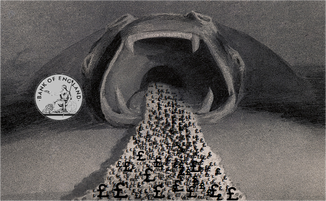
Its insatiable love for lucre has led it on a hell-bent mission to churn out the stuff in colossal quantities.
This is known quaintly as “quantitative easing”.
Fortunately, the super intelligent electronic age in which we live means that the Bank of England doesn’t need to print money like it did in ye olden times. These days a simple press of a button is all it takes to magic it up.
And we are talking big magic.
An estimated £375bn – and counting.(1)
Meanwhile, bankers get bonuses for failure. HSBC has been implicated in drug running and money laundering. And those clever boys at Barclays Bank have been diligently manipulating the LIBOR rate. Oh, and don’t forget the ever-increasing and ever-more costly efforts being made to save the Euro.
For a long time I struggled and failed to comprehend this will-o’-the-wisp economics. Now, however, it all makes perfect sense.
You see, the mistake I made was to think that I was living in a town called Nottingham in the middle of England. Whereas in reality I am a resident of the Dream Realm in a city known as Pearl.
One thing above all others characterises this place: it's an all-pervading fraudulence. This condition is so pervasive that it is easily overlooked.
To the casual glance, buying and bargaining go on here according to the same customs as everywhere. This, however, is mere pretence, a grotesque sham. The whole of the money economy is “symbolic”. You never know how much you have. Money comes and goes, is handed out and taken in: everyone practices a certain amount of sleight of hand and quickly picks up a few neat ploys. The trick is to sound plausible. You only have to pretend to be handing something over. Here fantasies are simply reality. The incredible thing is the way the same illusion appears in several minds at once. People talk themselves into believing the things they imagined.
Everything required to understand the likes of Bob Diamond, Barclays Bank, the Bank of England and the LIBOR-rate rigging scandal is contained in that one paragraph.
The words are not mine: they are taken from Alfred Kubin’s The Other Side (Die Andere Seite). The Austrian expressionist artist wrote this mind-blowing novel in 1909. Little did he know that, over a century later, it would help me come to terms with an early 21st century financial crisis.
I am re-reading the book in conjunction with Nottingham Contemporary’s exhibition of early works by Kubin. The show opens on Saturday 21st July. I can’t wait to see it.
The staff at Nottingham Contemporary have rather unwisely asked me to lead a guided tour through the exhibition at 1 o’clock on Wednesday 1st August.(3)
What on earth will I talk about?
Thankfully – in contrast to our financial services – a “strong hand” dictates all that occurs in the Dream Realm.
So I certainly shouldn’t be lacking Kubinesque inspiration...
____
Notes
(1) “Q&A: Quantitative easing”, http://www.bbc.co.uk/news/business-15198789.
(2) Alfred Kubin, The Other Side, transl. Mike Mitchell (Sawtry: Dedalus, 2000). The modified quotations reproduced here are taken from pages 60 and 62.
(3) “Wednesday Walk Throughs”, http://www.nottinghamcontemporary.org/event/wednesday-walk-throughs-4.






